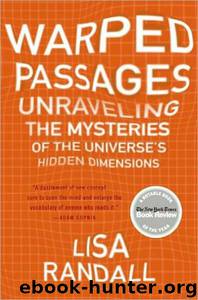Warped Passages by Lisa Randall

Author:Lisa Randall
Language: eng
Format: mobi, epub
Tags: Non-fiction, Science
ISBN: 9780061981234
Publisher: Harper Perennial
Published: 2005-01-01T00:00:00+00:00
“Super” words abound in physics terminology. We have superconducting, supercooling, supersaturated, superfluid, the Super conducting Supercollider (the SSC)—which would have been the highest-energy collider today had Congress not canceled it in 1993—and the list goes on. So you can imagine the excitement when physicists discovered that spacetime symmetry itself has a bigger, “super” version.
The discovery of supersymmetry was truly surprising. At the time when supersymmetric theories were first developed, physicists thought they knew all the symmetries of space and time. Spacetime symmetries are the more familiar symmetries that we saw in Chapter 9, which declare that you can’t tell where you are or which way you’re facing or what time it is solely from physical laws. The trajectory of a basketball, for example, doesn’t depend on which side of the court you’re on or if you play the game in California or New York.
In 1905, with the arrival of relativity theory, the list of spacetime symmetry transformations expanded to include those that change velocity (speed and direction of motion). But, physicists thought, that topped the list. No one believed that there could be other undiscovered symmetries involving space and time. Two physicists, Jeffrey Mandula and Sidney Coleman, codified this intuition in 1967 by proving that there could be no other such symmetries. However, they (and everyone else) had overlooked one possibility based on unconventional assumptions.
This chapter introduces supersymmetry, a strange new symmetry transformation that interchanges bosons and fermions. Physicists can now construct theories that incorporate supersymmetry. However, supersymmetry as a symmetry of nature is still hypothetical, since no one has yet discovered supersymmetry in the world around us. Nonetheless, physicits have two major reasons to think that it might exist in the world:
One reason is the superstring, which will be more thoroughly investigated in the chapter that follows. Superstring theory, which incorporates supersymmetry, is the only known version of string theory that has the potential to reproduce the particles of the Standard Model. String theory without supersymmetry doesn’t look as if it could possibly describe our universe.
The second reason is that supersymmetric theories have the potential to solve the hierarchy problem. Supersymmetry doesn’t necessarily explain the origin of the large ratio of the weak scale mass to the Planck scale mass, but it does eliminate the problematic enormous quantum contributions to the Higgs particle’s mass. The hierarchy problem is a serious conundrum for which very few suggestions have survived experimental and theoretical scrutiny. Before extra-dimensional theories were introduced as potential alternatives, supersymmetry was the lone candidate solution.
Because no one yet knows whether or not supersymmetry exists in the external world, all we can do at this point is evaluate candidate theories and their consequences. This way, when experiments reach higher energy, we’ll be prepared to figure out what the physical theory underlying the Standard Model really is. So let’s take a look at what could lie in store.
Download
This site does not store any files on its server. We only index and link to content provided by other sites. Please contact the content providers to delete copyright contents if any and email us, we'll remove relevant links or contents immediately.
| Atomic & Nuclear Physics | Particle Physics |
The Complete Stick Figure Physics Tutorials by Allen Sarah(7307)
Secrets of Antigravity Propulsion: Tesla, UFOs, and Classified Aerospace Technology by Ph.D. Paul A. Laviolette(5309)
Thing Explainer by Randall Munroe(3877)
The River of Consciousness by Oliver Sacks(3539)
The Order of Time by Carlo Rovelli(3145)
How To by Randall Munroe(3034)
A Brief History of Time by Stephen Hawking(2960)
I Live in the Future & Here's How It Works by Nick Bilton(2935)
The Great Unknown by Marcus du Sautoy(2646)
What If?: Serious Scientific Answers to Absurd Hypothetical Questions by Randall Munroe(2637)
Midnight in Chernobyl by Adam Higginbotham(2483)
Blockchain: Ultimate Step By Step Guide To Understanding Blockchain Technology, Bitcoin Creation, and the future of Money (Novice to Expert) by Keizer Söze(2445)
Networks: An Introduction by Newman Mark(2360)
The Meaning of it All by Richard Feynman(2300)
Easy Electronics by Charles Platt(2281)
The Tao of Physics by Fritjof Capra(2229)
Midnight in Chernobyl: The Untold Story of the World's Greatest Nuclear Disaster by Adam Higginbotham(2177)
When by Daniel H Pink(2082)
Introducing Relativity by Bruce Bassett(2076)
